
- Homepage
- Author
- Aleister Crowley (6)
- Arthur Von Mayer (15)
- Bram Stoker (8)
- Charles Dickens (9)
- Dan Brown (7)
- Dr. Seuss (18)
- Ernest Hemingway (9)
- Frank Herbert (9)
- George Orwell (12)
- Howe, George (6)
- J.k. Rowling (44)
- J.r.r. Tolkien (16)
- Kurban Said (6)
- L. Frank Baum (9)
- Margaret Mitchell (8)
- Mark Twain (8)
- Robert Paul Smith (6)
- Rudyard Kipling (16)
- Stephen King (28)
- Wendell Berry (9)
- Other (2634)
- Book Title
- Format
- Language
- Subject
- Americana (30)
- Art & Photography (98)
- Children's (115)
- Cooking (9)
- Exploration & Travel (29)
- History (151)
- Illustrated (31)
- Law & Government (8)
- Literature (6)
- Literature & Fiction (504)
- Men (6)
- Military & War (18)
- Outdoor & Nature (11)
- Performing Arts (7)
- Philosophy (20)
- Poetry (13)
- Reference (9)
- Science & Medicine (47)
- Self-help (10)
- Sports & Recreation (9)
- Other (1752)
- Type
THE GREAT GATSBY! (FIRST EDITION/FIRST PRINTING!)1925! F. Scott Fitzgerald RARE
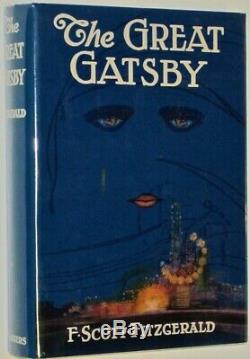
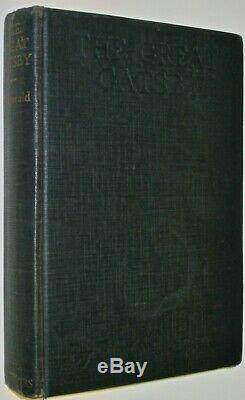

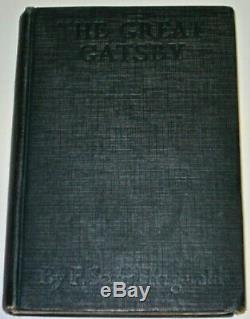
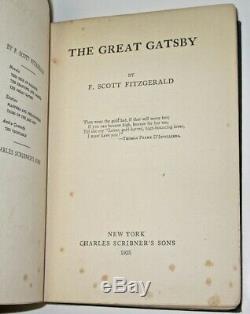
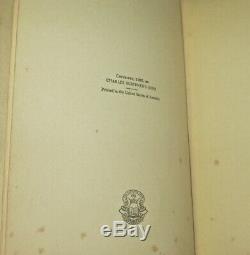
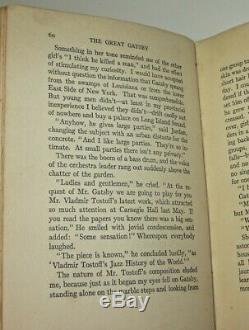
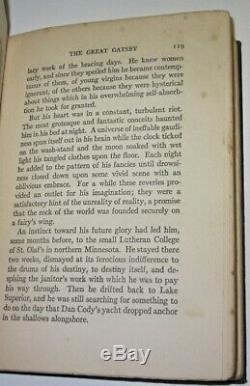
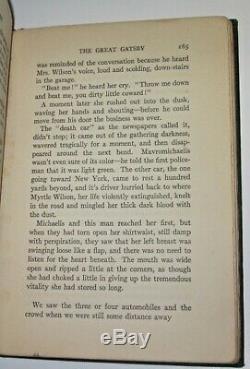
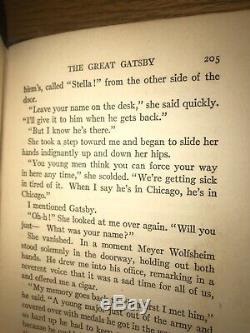
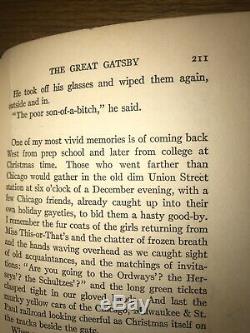
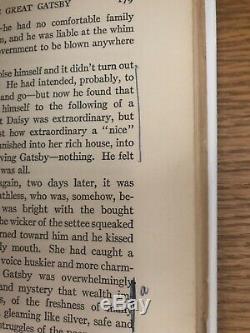


The dust jacket is a facsimile, that is included to protect the rare FIRST EDITION book. This book is the rare and highly desirable First Edition of The Great Gatsby. This book is only in Good to Very Good condition, with generalized usage wear consistent with that book grade, and with some pen underlining and marking. Some wear and abrasions to the binding, etc...
Some dirt stains or thumbing, and several pages have ballpoint pen drawn in the margins to highlight text and there is evidence of some conservation to remove some of this ink. There are some stains and there is ink underlining to some portions of the text. This is the correct First Issue, with the following 7 correct First Issue points. (As shown in the pictures). I don't recall if this book is possible to be found in mixed state.
Page 60, line 16 "chatter" (as shown in the pictures). Page 119, line 22 "northern" (as shown in the pictures). Page 165, line 16 "it's" (as shown in the pictures).
Page 205, lines 9-10 "sick in tired". Page 206, line sick in tired. Page 211, lines 7-8 Union Street station. The Great Gatsby From Wikipedia, the free encyclopediaJump to navigationJump to searchThis article is about the novel. For the film, TV and opera adaptations, see The Great Gatsby (disambiguation).
Not to be confused with Gadsby (novel). The Great Gatsby Cover of the first edition in 1925AuthorF. Scott FitzgeraldCover artistFrancis CugatCountryUnited StatesLanguageEnglishGenreNovelPublishedApril 10, 1925 (US). February 10, 1926 (UK)PublisherCharles Scribner's Sons (US). Chatto & Windus (UK)Media typePrint (hardcover & paperback)Pages218 (Original US Edition)Preceded by The Beautiful and Damned (1922) Followed by Tender Is the Night (1934).The Great Gatsby is a 1925 novel written by American author F. Scott Fitzgerald that follows a cast of characters living in the fictional towns of West Egg and East Egg on prosperous Long Island in the summer of 1922.
The story primarily concerns the young and mysterious millionaire Jay Gatsby and his quixotic passion and obsession with the beautiful former debutante Daisy Buchanan. Considered to be Fitzgerald's magnum opus, The Great Gatsby explores themes of decadence, idealism, resistance to change, social upheaval, and excess, creating a portrait of the Roaring Twenties that has been described as a cautionary[a] tale regarding the American Dream.
Fitzgeraldinspired by the parties he had attended while visiting Long Island's North Shorebegan planning the novel in 1923, desiring to produce, in his words, something new something extraordinary and beautiful and simple and intricately patterned. [3] Progress was slow, with Fitzgerald completing his first draft following a move to the French Riviera in 1924. [4]His editor, Maxwell Perkins, felt the book was vague and persuaded the author to revise over the following winter.Fitzgerald was repeatedly ambivalent about the book's title and he considered a variety of alternatives, including titles that referred to the Roman character Trimalchio; the title he was last documented to have desired was Under the Red, White, and Blue. [6][7] Fitzgerald died in 1940, believing himself to be a failure and his work forgotten. [8]However, the novel experienced a revival during World War II, [9] and became a part of American high school curricula and numerous stage and film adaptations in the following decades. [10] Today, The Great Gatsby is widely considered to be a literary classic and a contender for the title of the Great American Novel. Further information: Roaring Twenties and Jazz Age.
Set on the prosperous Long Island of 1922, The Great Gatsby provides a critical social history of America during the Roaring Twenties within its fictional narrative. That eraknown for widespread economic prosperity, the development of jazz music, flapper culture, new technologies in communication (motion pictures, broadcast radio, recorded music) forging a genuine mass culture, and bootlegging, along with other criminal activityis depicted in Fitzgerald's novel.Fitzgerald uses many of these societal developments of the 1920s to build Gatsby's stories, from many of the simple details such as automobiles to broader themes such as Fitzgerald's discreet allusions to the organized crime culture which was the source of Gatsby's fortune. [14] Fitzgerald depicts the garish society of the Roaring Twenties by placing the book's plotline within the historical context of the era.
Many of the events in Fitzgerald's early life are reflected throughout The Great Gatsby. Fitzgerald was a young man from Minnesota, and, like the novel's narrator, who went to Yale, he was educated at an Ivy League school, Princeton. Fitzgerald is also similar to Jay Gatsby in that he fell in love while stationed far from home in the military and fell into a life of decadence trying to prove himself to the girl he loved. Fitzgerald became a second lieutenant and was stationed at Camp Sheridan in Montgomery, Alabama.There he met and fell in love with a wild 17-year-old beauty named Zelda Sayre. Zelda finally agreed to marry him, but her preference for wealth, fun, and leisure led her to delay their wedding until he could prove a success. Like Nick in The Great Gatsby , Fitzgerald found this new lifestyle seductive and exciting, and, like Gatsby, he had always idolized the very rich. [16] In many ways, The Great Gatsby represents Fitzgerald's attempt to confront his conflicted feelings about the Jazz Age. [b] Like Gatsby, Fitzgerald was driven by his love for a woman who symbolized everything he wanted, even as she led him toward everything he despised.
George Wilson and his wife Myrtle live in the "valley of ashes, " a refuse dump (shown in the above photograph) historically located in New York City during the 1920s. Today, the area is Flushing MeadowsCorona Park. In the summer of 1922, Nick Carraway, a Yale graduate from the Midwest and veteran of the Great Warwho serves as the novel's narratortakes a job in New York as a bond salesman. He rents a small house on Long Island, in the fictional village of West Egg, next door to the lavish mansion of Jay Gatsby, a mysterious multi-millionaire who holds extravagant parties but does not participate in them.
Nick drives around the bay to East Egg for dinner at the home of his beautiful cousin, Daisy Fay Buchanan, and her husband, Tom, a college acquaintance of Nick's. They introduce Nick to Jordan Baker, an attractive, cynical young golfer. She reveals to Nick that Tom has a mistress, Myrtle Wilson, who lives in the "valley of ashes, "[18] an industrial dumping ground between West Egg and New York City. Not long after this revelation, Nick travels to New York City with Tom to a garage owned by Myrtle's husband George Wilson before heading to an apartment that Tom uses for trysts with Myrtle, as well as other women with whom he has sex.
At Tom's New York apartment, a vulgar and bizarre party ensues, ending with Tom striking Myrtle and breaking her nose after she angers him by saying Daisy's name several times. Nick eventually receives an invitation to one of Gatsby's parties.Nick encounters Jordan Baker at the party and they meet Gatsby himself, an aloof and surprisingly young man who recognizes Nick because they were in the same division in the Great War. Through Jordan, Nick later learns that Gatsby knew Daisy through a purely chance meeting in 1917 when Daisy and her friends were volunteering with young officers headed to Europe.
From their brief meetings and casual encounters at the time, Gatsby became (and still is) deeply in love with Daisy. Gatsby had hoped that his wild parties would attract an unsuspecting Daisy, who lives across the bay, to appear at his doorstep and allow him to present himself as a man of wealth and position. The twenty-story luxury Plaza Hotelin the early 1920s. Having developed a budding friendship with Nick, Gatsby uses him to arrange a reunion with Daisy: Nick invites Daisy to have tea at his house without telling her that Gatsby will also be there. After an initially awkward reunion, Gatsby takes Nick and Daisy to his large mansion in an attempt to demonstrate his wealth and sophistication.Daisy, Nick and, Gatsby spend the day enjoying all the activities Gatsby can provide and Nick realizes Daisy is also in love with Gatsby. Soon, the two begin an affair.
At a luncheon at the Buchanan estate, Daisy speaks to Gatsby with such undisguised intimacy that Tom realizes their affair. Although Tom is an adulterer, he is outraged by his wife's infidelity. The group drives to the Plaza Hotel, where Tom confronts Gatsby in his suite, asserting that he and Daisy have a history that Gatsby could never understand. In addition, he discloses that Gatsby is a criminal whose fortune comes from bootlegging alcohol and other illegal activities. Daisy decides to stay with Tom, and Tom contemptuously sends her back to East Egg with Gatsby, attempting to prove that Gatsby cannot hurt him. So we beat on, boats against the current, borne back ceaselessly into the past.Scott Fitzgerald, The Great Gatsby [19]. On the way back, Gatsby's car strikes and kills Tom's mistress, Myrtle. Nick later learns that Daisy, not Gatsby, was driving the car at the time of the accident. George mistakenly concludes that the driver of the yellow car is his wife's secret lover. George learns from Tom that the yellow car is Jay Gatsby's.
George fatally shoots Gatsby in Gatsby's swimming pool before turning the gun on himself. Nick organizes a funeral for Gatsby, but only one of Gatsby's party-goers and his estranged father, Henry Gatz, attend. None of Gatsby's business associates attend, nor does Daisy. Nick runs into Tom in New York and learns that it was Tom who told George that the yellow car belonged to Gatsby and gave him Gatsby's address. Disillusioned with the East, Nick moves back to the Midwest, having decided not to tell Tom that it was Daisy behind the wheel of the car that killed Myrtle.Ginevra King (left)whom Fitzgerald romantically pursuedinspired the character of Daisy Buchanan. Edith Cummings (right) was an amateur golfer who inspired the character of Jordan Baker. Both were fêted in the press as among Chicago's "four most desirable" debutantes. Nick Carraway a Yale University graduate from the Midwest, a World War I veteran, and, at the start of the plot, a newly arrived resident of West Egg, age 29 (later 30).
He also serves as the first-person narrator of the novel. He is Gatsby's next-door neighbor and a bond salesman. He is easy-going, occasionally sarcastic, and somewhat optimistic, although this latter quality fades as the novel progresses. He is more grounded and more practical than the other characters, and is always in awe of their lifestyles and morals. Jay Gatsby (originally James "Jimmy" Gatz)a young, mysterious millionaire with shady business connections (later revealed to be a bootlegger), originally from North Dakota.
He is obsessed with Daisy Buchanan, a beautiful debutante whom he met when he was a young military officer stationed at the Army's Camp Taylor in Louisville, Kentucky, during World War I. Gatsby is also said to have briefly studied at Trinity College, Oxford in England after the end of the war.[21] According to Fitzgerald's wife Zelda, the character was based on the bootlegger and former World War I officer, Max Gerlach. Daisy Buchanan an attractive, though shallow and self-absorbed, young debutante and socialite from Louisville, Kentucky, identified as a flapper. [23] She is Nick's second cousin once removed, and the wife of Tom Buchanan.
Before she married Tom, Daisy had a romantic relationship with Gatsby. Her choice between Gatsby and Tom is one of the central conflicts in the novel. The character of Daisy is believed to have been inspired by Fitzgerald's youthful romances with Ginevra King. Thomas "Tom" Buchanan a millionaire who lives in East Egg, and Daisy's husband.
Tom is an imposing man of muscular build with a "husky tenor" voice and arrogant demeanor. He was a football star at Yale University. Buchanan has parallels with William Mitchell, the Chicagoan who married Ginevra King. [25] Buchanan and Mitchell were both Chicagoans with an interest in polo. Like Ginevra's father, whom Fitzgerald resented, Buchanan attended Yale and is a white supremacist. Jordan Baker an amateur golfer and Daisy Buchanan's long-time friend with a sarcastic streak and an aloof attitude. She is Nick Carraway's girlfriend for most of the novel, though they grow apart towards the end. She has a slightly shady reputation because of rumors that she had cheated in a tournament, which harmed her reputation socially and as a golfer. Fitzgerald told Maxwell Perkins that Jordan was based on the golfer Edith Cummings, a friend of Ginevra King, though Cummings was never suspected of cheating. [26] Her name is a play on the two popular automobile brands, the Jordan Motor Car Company and the Baker Motor Vehicle, alluding to Jordan's "fast" reputation and the new freedom presented to Americans, especially women, in the 1920s.Wilson a mechanic and owner of a garage. He is disliked by both his wife, Myrtle Wilson, and Tom Buchanan, who describes him as so dumb he doesn't know he's alive.
At the end of the novel, he kills Gatsby, wrongly believing that he had been driving the car that killed Myrtle, and then kills himself. Myrtle Wilson George's wife, and Tom Buchanan's mistress. Myrtle, who possesses a fierce vitality, is desperate to find refuge from her disappointing marriage. She is accidentally killed by Gatsby's car, as she thinks it is Tom still driving and runs after it (driven by Daisy, though Gatsby takes the blame for the accident). Meyer Wolfsheim [c]a Jewish friend and mentor of Gatsby's, described as a gambler who fixed the 1919 World Series. Wolfsheim appears only twice in the novel, the second time refusing to attend Gatsby's funeral. He is a clear allusion to Arnold Rothstein, [32] a New York crime kingpin who was notoriously blamed for the Black Sox Scandal that tainted the 1919 World Series. The now-demolished Beacon Towers partly served as an inspiration for Gatsby's home. Oheka Castle was another North Shore inspiration for the novel's setting. Fitzgerald began planning his third novel in June 1922, [14] but it was interrupted by production of his play, The Vegetable , in the summer and fall.[34] The play failed miserably, and Fitzgerald worked that winter on magazine stories struggling to pay his debt caused by the production. [35][36] The stories were, in his words, "all trash and it nearly broke my heart, "[36] although included among those stories was "Winter Dreams, " which Fitzgerald later described as a sort of first draft of the Gatsby idea. After the birth of their only child, Frances Scott "Scottie" Fitzgerald, the Fitzgeralds moved in October 1922 to Great Neck, New York, on Long Island. The town was used as the scene of The Great Gatsby. [38] Fitzgerald's neighbors in Great Neck included such prominent and newly wealthy New Yorkers as writer Ring Lardner, actor Lew Fields, and comedian Ed Wynn.
This real-life juxtaposition gave Fitzgerald his idea for "West Egg" and East Egg. [39] Several mansions in the area served as inspiration for Gatsby's home, such as Oheka Castle[40] and Beacon Towers, since demolished. [41] Another possible inspiration was Land's End, a notable Gold Coast Mansion where Fitzgerald may have attended a party. While the Fitzgeralds were living in New York, the Hall-Mills murder case was sensationalized in the daily newspapers over the course of many months, and the highly-publicized case likely influenced the plot of Fitzgerald's novel.
[43] The case involved the double-murder of a man and his lover which occurred on September 14, 1922, mere weeks before Fitzgerald and his wife arrived in Great Neck. Scholars have speculated that Fitzgerald based certain aspects of the ending of The Great Gatsby as well as various characterizations on this factual incident.
By mid-1923, Fitzgerald had written 18,000 words for his novel, [45] but discarded most of his new story as a false start. Some of it, however, resurfaced in the 1924 short story Absolution. [14][46][47] Work on The Great Gatsby began in earnest in April 1924. Fitzgerald wrote in his ledger, Out of woods at last and starting novel.
"[36] He decided to make a departure from the writing process of his previous novels and told Perkins that the novel was to be a "consciously artistic achievement"[48] and a "purely creative worknot trashy imaginings as in my stories but the sustained imagination of a sincere and yet radiant world. [49][50] Soon after this burst of inspiration, work slowed while the Fitzgeralds made a move to the French Riviera, where a serious crisis[d] in their relationship soon developed. [36] By August, however, Fitzgerald was hard at work and completed what he believed to be his final manuscript in October, sending the book to his editor, Maxwell Perkins, and agent, Harold Ober, on October 30. [36] The Fitzgeralds then moved to Rome for the winter. [51] Fitzgerald made revisions through the winter after Perkins informed him in a November letter that the character of Gatsby was "somewhat vague" and Gatsby's wealth and business, respectively, needed "the suggestion of an explanation" and should be adumbrated. "[52] Fitzgerald thanked Perkins for his detailed criticisms and stated, "With the aid you've given me I can make Gatsby perfect.[54] Fitzgerald's revisions included an extensive rewriting of Chapter VI and VIII. Unlike Gatsby and Tom Buchanan, I had no girl whose disembodied face floated along the dark cornices and blinding signs... [57]Early drafts of the book cover made by illustrator Francis Cugat. The cover of the first printing of The Great Gatsby is among the most celebrated pieces of art in American literature. [57]It depicts disembodied eyes and a mouth over a blue skyline, with images of naked women reflected in the irises.
A little-known artist named Francis Cugat was commissioned to illustrate the book while Fitzgerald was in the midst of writing it. [57] The cover was completed before the novel, and Fitzgerald was so enamored with it that he told his publisher he had "written it into" the novel. [58] Fitzgerald's remarks about incorporating the painting into the novel led to the interpretation that the eyes are reminiscent of those of fictional optometrist Dr. Eckleburg, [59] depicted on a faded commercial billboard near George Wilson's auto repair shop, which Fitzgerald described as.
Although this passage has some resemblance to the painting, a closer explanation can be found in the description of Daisy Buchanan as the girl whose disembodied face floated along the dark cornices and blinding signs. "[57] Years later, Ernest Hemingway wrote in A Moveable Feast that when Fitzgerald lent him a copy of The Great Gatsby to read, he immediately disliked the cover, but "Scott told me not to be put off by it, that it had to do with a billboard along a highway in Long Island that was important in the story.
He said he had liked the jacket and now he didn't like it. Fitzgerald's editor, Maxwell Perkins, convinced the author to abandon his original title of Trimalchio in West Egg in favor of The Great Gatsby. Fitzgerald had difficulty choosing a title for his novel and entertained many choices before reluctantly choosing The Great Gatsby , [61] a title inspired by Alain-Fournier's Le Grand Meaulnes. [62] Previously he had shifted between Gatsby , Among Ash-Heaps and Millionaires , Trimalchio , [5] Trimalchio in West Egg , [63] On the Road to West Egg , [64] Under the Red, White, and Blue , [5] The Gold-Hatted Gatsby , [5][64] and The High-Bouncing Lover. [5][64] The titles The Gold-Hatted Gatsby and The High-Bouncing Lover came from Fitzgerald's epigraph for the novel, one which he wrote himself under the pen name of Thomas Parke D'Invilliers. [65] He initially preferred titles referencing Trimalchio , the crude parvenu in Petronius's Satyricon , and even refers to Gatsby as Trimalchio once in the novel. Unlike Gatsby's spectacular parties, Trimalchio participated in the audacious and libidinous orgies he hosted but, according to Tony Tanner's introduction to the Penguin edition, there are subtle similarities between the two. In November 1924, Fitzgerald wrote to Perkins that I have now decided to stick to the title I put on the book... Trimalchio in West Egg , [68] but was eventually persuaded that the reference was too obscure and that people would not be able to pronounce it. [69]His wife, Zelda, and Perkins both expressed their preference for The Great Gatsby and the next month Fitzgerald agreed. [70] A month before publication, after a final review of the proofs, he asked if it would be possible to re-title it Trimalchio or Gold-Hatted Gatsby but Perkins advised against it. On March 19, 1925, [71] Fitzgerald expressed intense enthusiasm for the title Under the Red, White and Blue , but it was at that stage too late to change. [72][73] The Great Gatsby was published on April 10, 1925. [74] Fitzgerald remarked that the title is only fair, rather bad than good. Early drafts of the novel have been published under the title Trimalchio: An Early Version of The Great Gatsby. [76][77] A notable difference between the Trimalchio draft and The Great Gatsby is a less complete failure of Gatsby's dream in Trimalchio.The Great Gatsby was published by Charles Scribner's Sons on April 10, 1925. Fitzgerald called Perkins on the day of publication to monitor reviews: Any news? "[36]"Sales situation doubtful, " read a wire from Perkins on April 20, "[but] excellent reviews. " Fitzgerald responded on April 24, saying the cable "depressed" him, closing the letter with "Yours in great depression. [6][7] Despite this, Scribner's continually kept the book in print; they carried the original edition on their trade list until 1946, by which time Gatsby was in print in three other forms and the original edition was no longer needed.
[36] Fitzgerald received letters of praise from contemporaries T. Eliot, Edith Wharton, and Willa Cather regarding the novel; however, this was private opinion, and Fitzgerald feverishly sought the public recognition of reviewers and readers.
Menckendismissed the novel upon its publication as lacking in substance, although he praised its ending. The Great Gatsby received mixed reviews from literary critics of the day. Generally the most effusive of the positive reviews was Edwin Clark of The New York Times , who felt the novel was A curious book, a mystical, glamourous [sic] story of today. Ford of the Los Angeles Times wrote, "[the novel] leaves the reader in a mood of chastened wonder, " calling the book "a revelation of life" and a work of art. "[80] The New York Post called the book "fascinating...
His style fairly scintillates, and with a genuine brilliance; he writes surely and soundly. "[81] The New York Herald Tribune was less impressed, referring to The Great Gatsby as "purely ephemeral phenomenon, but it contains some of the nicest little touches of contemporary observation you could imagineso light, so delicate, so sharp... [82] In The Chicago Daily Tribune , H. Mencken called the book "in form no more than a glorified anecdote, and not too probable at that, " while praising the book's "charm and beauty of the writing" and the careful and brilliant finish.
The thing that chiefly interests the basic Fitzgerald is still the florid show of modern American lifeand especially the devil's dance and that goes on at the top. Their idiotic pursuit of sensation, their almost incredible stupidity and triviality, their glittering swinishnessthese are the things that go into his notebook. Mencken, Chicago Tribune , May 1925[84]. Several writers felt that the novel left much to be desired following Fitzgerald's previous works and promptly criticized him. Harvey Eagleton of The Dallas Morning News believed the novel signaled the end of Fitzgerald's success: One finishes Great Gatsby with a feeling of regret, not for the fate of the people in the book, but for Mr.
"[85] John McClure of The Times-Picayune said that the book was unconvincing, writing, "Even in conception and construction, The Great Gatsby seems a little raw. [86] Ralph Coghlan of the St. Louis Post-Dispatch felt the book lacked what made Fitzgerald's earlier novels endearing and called the book a minor performance... At the moment, its author seems a bit bored and tired and cynical.
"[87] Ruth Snyder of New York Evening World called the book's style "painfully forced, " noting that the editors of the paper were "quite convinced after reading The Great Gatsby that Mr. Fitzgerald is not one of the great American writers of to-day. "[88] The reviews struck Fitzgerald as completely missing the point: "All the reviews, even the most enthusiastic, not one had the slightest idea what the book was about.
Fitzgerald's goal was to produce a literary work which would truly prove himself as a writer, [89] and Gatsby did not have the commercial success of his two previous novels, This Side of Paradise and The Beautiful and Damned. Although the novel went through two initial printings, some of these copies remained unsold years later. [90]Fitzgerald himself blamed poor sales on the fact that women tended to be the main audience for novels during this time, and Gatsby did not contain an admirable female character. [36] For several years afterward, the general public believed The Great Gatsby to be nothing more than a nostalgic period piece.
[36] By the time Fitzgerald died in 1940, the novel had fallen into near obscurity. Fitzgerald's friend Edmund Wilson helped revive the author's posthumous reputation. In 1940, Fitzgerald suffered a third and fatal heart attack, and died believing his work forgotten. [92] His obituary in The New York Times mentioned Gatsby as Fitzgerald at his best.[93] A strong appreciation for the book gradually developed in underground circles. Future writers Edward Newhouse and Budd Schulberg were deeply affected by it, and author John O'Hara acknowledged its influence. [94] The republication of Gatsby in Edmund Wilson's edition of The Last Tycoon in 1941 produced an outburst of comment, with the general consensus expressing the sentiment that the book was an enduring work of fiction. In 1942, a group of publishing executives created the Council on Books in Wartime. The Council's purpose was to distribute paperback books to soldiers fighting in the Second World War.
The Great Gatsby was one of these books. The books proved to be "as popular as pin-up girls" among the soldiers, according to the Saturday Evening Post's contemporary report. [95] 155,000 copies of Gatsby were distributed to soldiers overseas. By 1944, full-length articles on Fitzgerald's works were being published, and the following year, the opinion that Gatsby was merely a period piece had almost entirely disappeared. [36] This revival was paved by interest shown by literary critic Edmund Wilson, who was Fitzgerald's friend.
[97] In 1951, Arthur Mizener published The Far Side of Paradise , a biography of Fitzgerald. [98] He emphasized The Great Gatsby's positive reception by literary critics, which may have influenced public opinion and renewed interest in it.
Following the novel's revival, later critical writings on The Great Gatsby focus in particular on Fitzgerald's disillusionment with the American dream[a] in the context of the hedonistic Jazz Age, [b] a name for the era which Fitzgerald claimed to have coined. [100] In 1970, scholar Roger L. Pearson published an essay in which he asserted that Fitzgerald has come to be associated with this concept of the American dream more than any other writer of the twentieth century. [101] Pearson traced the literary origins of this particular dream to Colonial America.However, Pearson noted that Fitzgerald's unique expression of the American dream lacks the optimism, the sense of fulfillment, so evident in the expressions of his predecessors. [101] He posited that Fitzgerald created the character of Gatsby to serve as a false prophet of the American dream and to demonstrate how that dream no longer exists except in the minds of those as materialistic as Gatsby. [102] Pearson concluded that the American dream pursued by Gatsby "is, in reality, a nightmare, " bringing nothing but discontent and disillusionment to those who chase it as they realize that it is unsustainable and ultimately unattainable. Echoing Pearson's interpretation, scholar Sarah Churchwell similarly views The Great Gatsby to be a cautionary tale of the decadent downside of the American dream. [103] Churchwell posits the story concerns the limits of America's ideals of social and class mobility, and the hopelessness of lower-class aspirants to transcend the stations of their birth.
[103] This is illustrated through the novel's narrator, Nick Carraway, who observes that a sense of the fundamental decencies is parcelled out unequally at birth. "[104] Churchwell posits that Fitzgerald's novel is "a story of class warfare in a nation that denies it even has a class system, in which the game is eternally rigged for the rich to win. In addition to exploring the trials and tribulations of achieving the American dream during the Jazz Age, The Great Gatsby explores societal gender expectations as a theme. Although early scholars viewed the character of Daisy Buchanan to be a "monster of bitchery, "[105] later scholars such as Leland S.
Asserted that Daisy's character exemplifies the marginalization of women in the East Egg social milieu that Fitzgerald depicts. [106][107] Writing in 1978, Person noted that. Daisy is thus reduced to a golden statue, a collector's item which crowns Gatsby's material success. [109] As an upper-class white woman living in East Egg during this time period, Daisy must adhere to societal expectations and gender norms such as actively fulfilling the roles of dutiful wife, mother, keeper of the house, and charming socialite. [106] Many of Daisy's choicesultimately culminating in the tragedy of the ending and misery for all those involvedcan be partly attributed to her prescribed role as a "beautiful little fool"[f] who is reliant on her husband for financial and societal security. [105] Her decision to remain with her husband despite her feelings for Gatsby is thus attributable to the status, security, and comfort that her marriage to Tom Buchanan provides.Journalist Nick Gillespie interprets The Great Gatsby as a story of the underlying permanence of class differences, even in the face of a modern economy based not on status and inherited position but on innovation and an ability to meet ever-changing consumer needs. [111] This interpretation asserts that The Great Gatsby captures the American experience because it is a story about change and those who resist it, whether the change comes in the form of a new wave of immigrants or the nouveau richeor successful minorities. [111] Americans living in the 1920s to the present are thus defined by their fluctuating economic and social circumstances. As Gillespie states, While the specific terms of the equation are always changing, it's easy to see echoes of Gatsby's basic conflict between established sources of economic and cultural power and upstarts in virtually all aspects of American society. [111] Because this can be seen throughout American history, readers are able to relate to The Great Gatsby , which has contributed to the novel's enduring popularity.
Postmodern criticism of Gatsby seeks to place the novel and its characters in historical context almost a century after its original publication. These interpretations argue that Jay Gatsby and The Great Gatsby can be viewed as the personification and representation of human-caused climate change, as "Gatsby's life depends on many human-centered, selfish endeavors" which are in some part responsible for Earth's current ecological crisis. The green light that shines at the end of the dock of Daisy's house across the Sound from Gatsby's house is frequently mentioned in the background of the plot. It has variously been interpreted as a symbol of Gatsby's longing for Daisy and, more broadly, of the American dream. Fitzgerald based the character of Meyer Wolfsheim on Jazz Ageracketeer Arnold Rothsteinwho was murdered in 1928.
Like many of Fitzgerald's works, The Great Gatsby has been accused of displaying anti-Semitism through the use of Jewish stereotypes. [113] The book describes Meyer Wolfsheim[c] as "a small, flat-nosed Jew, " with "tiny eyes" and "two fine growths of hair" in his nostrils, while his nose is described as "expressive, " "tragic, " and able to flash... [114] A dishonest and corrupt profiteer who assisted Gatsby's bootlegging operations and spearheaded the Black Sox scandal, Wolfsheim has also been seen as representing the Jewish miser stereotype. Richard Levy, author of Antisemitism: A Historical Encyclopedia of Prejudice and Persecution , claims that Wolfsheim is pointedly connected Jewishness and crookedness.
"[114] In a 1947 article for Commentary , Milton Hindus, an assistant professor of humanities at the University of Chicago, stated that while believed the book was "excellent" on balance, Wolfsheim "is easily its most obnoxious character, " and "the novel reads very much like an anti-Semitic document. " Hindus argued that the Jewish stereotypesdisplayed by Wolfsheim was typical of the time period in which the novel was written and set, and that any anti-Semitism was of the "habitual, customary,'harmless,' unpolitical variety. A 2015 article by Arthur Krystal agreed with Hindus' assessment that Fitzgerald's use of Jewish caricatures was not driven by malice and merely reflected commonly-held beliefs of his time.
He notes the accounts of Frances Kroll, a Jewish woman and secretary to Fitzgerald, who claimed that Fitzgerald was hurt by accusations of anti-Semitism and responded to critiques of Wolfsheim by claiming that he merely fulfilled a function in the story and had nothing to do with race or religion. [113] This claim is further supported by evidence that Wolfsheim was based on real-life Jewish gambler Arnold Rothstein. Cover of the first edition of The Great Gatsby'sItalian-language edition, as published by Mondadori in 1936. In 2009, BalletMet premiered a version at the Capitol Theatre in Columbus, Ohio. It was choreographed by Jimmy Orrante.
In 2010, The Washington Ballet premiered a version at the Kennedy Center. [116] It was received an encore run the following year. In 2013, the Northern Ballet premiered a version of The Great Gatsby at Leeds Grand Theatre in the UK, with choreography and direction by David Nixon, a musical score by Richard Rodney Bennett, and set designs by Jerome Kaplan. Nixon also created the scenario and costume designs. In 2010, Oberon Media released a casual hidden object game called Classic Adventures: The Great Gatsby.
[119][120] The game was released for iPad in 2012. In 2011, as a tribute to old NES games, developer Charlie Hoey and editor Pete Smith created an 8-bit-style online game of The Great Gatsby.
[122] Ian Crouch of The New Yorker compared it to The Adventures of Tom Sawyer (1989) for the NES. A lobby card for the 1926 film. The Great Gatsby has resulted in a number of film and television adaptations. The Great Gatsby (1926), by Herbert Brenonstarring Warner Baxter, Lois Wilson, and William Powell, now a lost film.
The Great Gatsby (1949), by Elliott Nugentstarring Alan Ladd, Betty Field, and Macdonald Carey. The Great Gatsby (1974), by Jack Claytonstarring Robert Redford, Mia Farrow, and Sam Waterston. The Great Gatsby (2000), by Robert Markowitza TV movie starring Toby Stephens, Mira Sorvino, and Paul Rudd. The Great Gatsby (2013), by Baz Luhrmannstarring Leonardo DiCaprio, Carey Mulligan, and Tobey Maguire.
The Double Bind (2007) by Chris Bohjalian imagines the later years of Daisy and Tom Buchanan's marriage, as a social worker in 2007 investigates the possibility that a deceased elderly homeless person is Daisy's son. Great (2014) by Sara Benincasa is a modern-day young adult fiction retelling of The Great Gatsby with a female Gatsby named Jacinta Trimalchio. The New York Metropolitan Opera commissioned John Harbison to compose an operatic treatment of the novel to commemorate the 25th anniversary of James Levine's debut. The work, called The Great Gatsby , premiered on December 20, 1999.
On January 1, 1950, an hour-long adaptation was broadcast on CBS's Family Hour of Stars starring Kirk Douglas as Gatsby. In October 2008, the BBC World Service commissioned an abridged 10-part reading of the story, read from the view of Nick Carraway by Trevor White. In May 2012, BBC Radio 4 broadcast The Great Gatsby , a Classic Serial dramatization by Robert Forrest. The 1926 stage adaptation of Owen Davis, [131] subsequently developed, became the 1926 film version.
The play, directed by George Cukor, opened on Broadway on February 2, 1926, and ran for 112 performances. A successful tour later in the year included performances in Chicago, 1 August 20 through 2 October. In July 2006, Simon Levy's stage adaptation, [133] the only one authorized and granted exclusive rights by the Fitzgerald estate, premiered at The Guthrie Theater to commemorate the opening of its new theatre, directed by David Esbjornson. It was subsequently produced by Seattle Repertory Theatre.
In 2012, a revised version was produced at Arizona Theatre Company[134] and Grand Theatre in London, Ontario, Canada. In 2010, Gatz , an Off-Broadway production by Elevator Repair Service, debuted and was highly praised by critic Ben Brantley of The New York Times. The item "THE GREAT GATSBY! Scott Fitzgerald RARE" is in sale since Friday, July 26, 2019. This item is in the category "Books\Antiquarian & Collectible". The seller is "merchants-rare-books" and is located in Moab, Utah.This item can be shipped worldwide.
- Publisher: Charles Scribner's Sons
- Modified Item: No
- Subject: Literature & Fiction
- Place of Publication: New York
- Topic: Classics
- Author: F. Scott Fitzgerald
- Year Printed: 1925
- Language: English
- Special Attributes: First Edition
- Original/Facsimile: Original
- Binding: Hardcover

